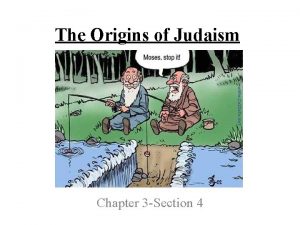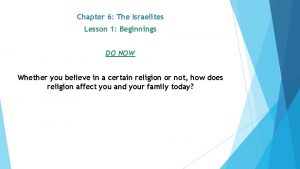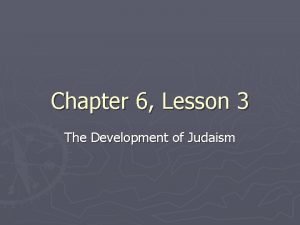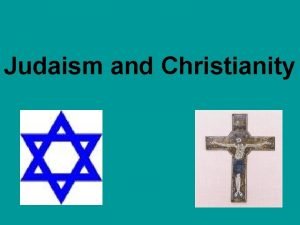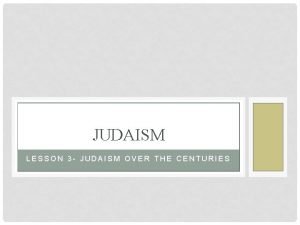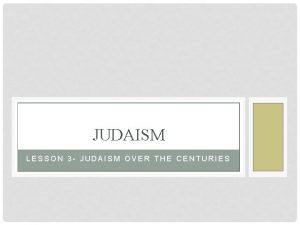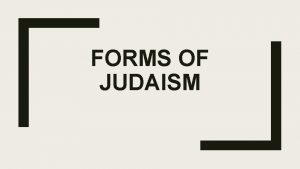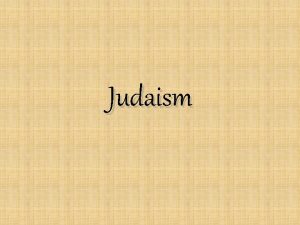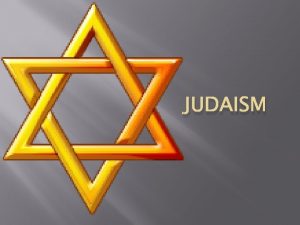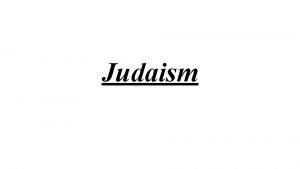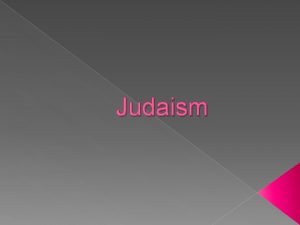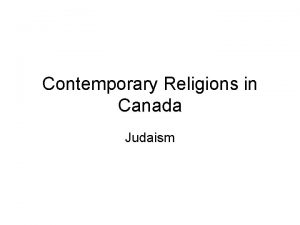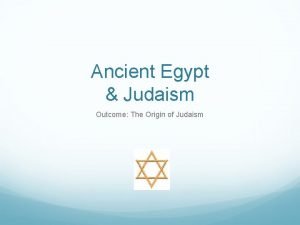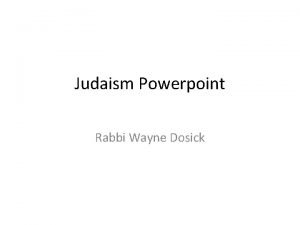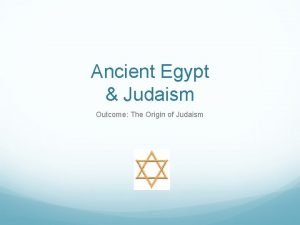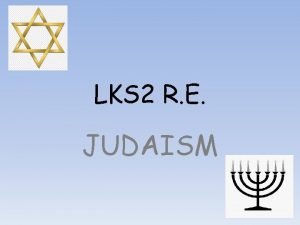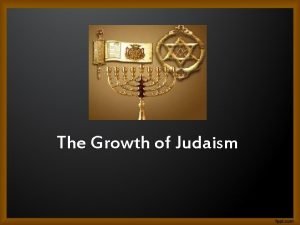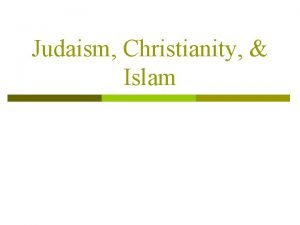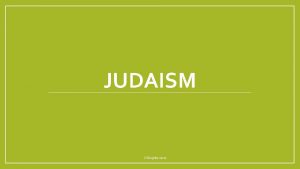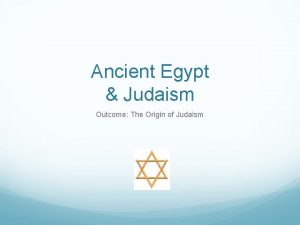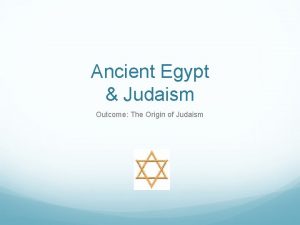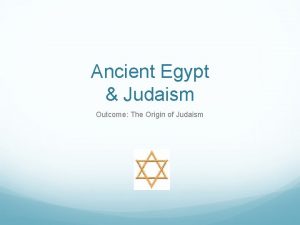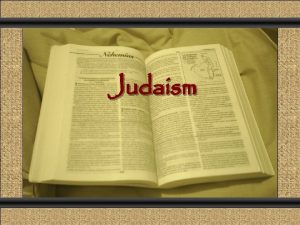Chapter 4 The Story of Judaism Judaism in


























- Slides: 26

Chapter 4 The Story of Judaism

Judaism in Canada • Canada has the fourth-largest Jewish population in the world, after the • • United States, Israel, and France. Approximately 330 000 Canadian Jews today trace their origins back to Russian and Eastern European Jews who emigrated to escape persecution during the late 19 th and early 20 th centuries. Others are descended from the 40 000 Holocaust survivors who came to Canada in 1945, after WWII. In the 1950 s, another wave of Jewish immigrants came from French colonies in North Africa. Most settled in large cities such as Montréal and Toronto. Many of the first Jewish Canadians were fur traders or members of the British Army stationed in the province of Québec. Today, the largest number of Jews in Canada live in Toronto and Montréal. Vancouver, Ottawa, Winnipeg, and Calgary also have large Jewish communities.

The History of Judaism Origins of Judaism • Judaism traces its origins back 3800 years to Abraham and Sarah, patriarch and matriarch of Hebrews or Israelites. • The story of Abraham, Sarah, and their descendants is told in Jewish scriptures. • It is the story of a covenant (promise) made between God and Abraham. Links to the Past • The area we now know as Israel was once divided into two kingdoms: the kingdom of Israel in the north and the kingdom of Judah in the south. • The religion is called Judaism because the Jewish people trace their heritage to the Hebrew people who lived in the kingdom of Judah. • Throughout its sacred texts, Judaism has maintained continuity with its distant past. • Even though Judaism’s roots date back to ancient times, over the centuries it has evolved and changed from the practices of early Hebrews.

The Birth of Modern Judaism • The Judaism of King David and King Solomon was different from the Judaism of • • • today. The destruction of the Temple in the 1 st century of the Common Era had an enormous impact on Judaism because it had been the centre of all Jewish worship and sacrifice. In 66 CE, Judea was under the Roman Empire. Zealots (Jewish revolutionaries) rebelled, and the Romans laid siege to Jerusalem, destroying the city and the Temple. 3000 people perished when the Temple fell. Christianity and Rabbinic Judaism survived, but were changed by the events.

Christianity • The destruction of the Temple forever changed a Jewish movement that had begun with Jesus of Nazareth about 40 years earlier. • The movement included Jews and non-Jews who had accepted Jesus as the Jewish Messiah or Christ. • Conflict developed between Christian Jews and Rabbinic Jews (Pharisees). • The two groups parted ways at the end of the 1 st century. Rabbinic Judaism • It was begun by Pharisees. • It found a new focus in sacred writings. • It encouraged people to gather in synagogues or study houses to study the Torah. • Torah is the “teaching” or guidance of God. • Studying and interpreting the Torah became an important way of helping Jewish people follow the laws of the covenant, wherever they lived. • Interpreters were known as scribes or rabbis, thus the name Rabbinic Judaism.

Jews in the Diaspora • In 135 CE, the Romans expelled the Jews from Judea, forcing them to take refuge in other countries. • Diaspora means “dispersion” or “scattering. ” • This scattering among nations and the constant desire to return to Israel and Jerusalem is a key aspect of the history of Jews and their faith. Jews in Christian Europe • In the Diaspora, Jews became divided into two major groups: the Ashkenazim in northern, central, and eastern Europe, and the Sephardim around the Mediterranean. • Both groups had an immeasurable influence on the intellectual, economic, cultural, and spiritual life of every country they lived in. • Jews were considered “the other” and were set apart in many cases. • In Christian countries of Europe, they were often unjustly accused of being the killers of Jesus the Messiah and were treated as unbelievers.

The Kabbalah and Hasidism • Several Jewish mystical movements became popular in the Middle Ages. • Mystics search for God through a life of prayer, meditation, and reflection. • The main Jewish mystical teachings are Kabbalah (12 th century), and Hasidism (18 th century). Kabbalah • Kabbalah’s teachings are found in many texts, including the Zohar. • According to Kabbalah, the true nature of God is indescribable. • It is known as Ein Sof, meaning “without end. ” • God has no boundaries in time or space. Hasidism • Founder was Israel ben Eliezer (1698– 1759), also known as Ba’al Shem Tov • He taught that communion with God happened through prayer, good deeds, humility, and joy. • He is best known for his humorous stories of people encountering God while doing simple chores.

The Enlightenment, the Holocaust (Shoah), and Modern-Day Israel • Three events have shaped Judaism in the past three centuries: the Enlightenment, the Holocaust (Shoah), and the founding of the State of Israel. The Enlightenment • In the 17 th century, a new way of knowing began to dominate Western Europe: reason. • Before that, mysticism and religion were ways of knowing and understanding life. • The Enlightenment emphasized intellectual freedom. • Only what could be known by reason was acceptable; everything else was • • superstition. People became skeptical of traditional political, social, and religious beliefs. Less emphasis was placed on religion, and Jews in some parts of Europe became more accepted. The Enlightenment also caused divisions within Judaism. Ashkenazi Jews split into three traditions: Reform, Conservative, and Orthodox.

Reform Judaism • This branch attracted Jews who had mixed more frequently with the rest of the • • • population They wanted to enjoy freedoms like everyone else, participate in intellectual life, and work with non-Jews. They began to interpret scripture with more modern methods. They became less concerned with traditional purity laws, kosher laws, and the desire to return to the homeland. Today, Reform Jews use a combination of Hebrew and English for religious services. Men and women sit together in the synagogue. Women are ordained as rabbis. Many, but not all, believe as long as one parent is Jewish, the children are Jewish. Individualism is encouraged: each person must decide what beliefs and practices are key to his or her spiritual life. They often accept secular moral values (the values of society in general), but live by traditional values as well. They stress tikkun olam—repairing the world through social action.

Conservative Judaism • The Conservative movement arose as a reaction to Reform Judaism. • It follows many, but not all, of the 613 commandments of the Torah, and old • • traditions such as the order of prayers, the use of Hebrew, and some dietary laws. It is open to modern historical methods of study, but considers Reform Judaism too loose in its interpretation of the scripture. The needs of the community and its Jewish identity always come before individual wants and needs. Active participation in synagogue is very important. Like Reform Jews, Conservatives stress tikkun olam. Men and women sit together in the synagogue. Women are sometimes ordained as rabbis. It is the largest branch of Judaism in Canada.

Orthodox Judaism • Orthodox Jews continue to observe all the ancient rules and practices. • They want to avoid “watering down” the Jewish faith. • They believe God gave the whole Torah—oral and written—to Moses at Mount Sinai. • Some Orthodox Jews accept some secular moral values, but being Orthodox means following the commandments of the Torah, strictly observing the Sabbath and other Jewish holy days, using Hebrew in the synagogue, dressing modestly, and following dietary laws. • Men and women sit separately in the synagogue. • Judaism can only be passed down to children by the mother.

The Holocaust (Shoah) • During WWII, between 16 and 20 million people were killed in concentration • • • and labour camps by German Nazis and their allies. About 6 million of these victims were Jews. Adolf Hitler was elected chancellor of Germany in 1933. Even though German Jews were well integrated into European society, Hitler considered them an “inferior race” and declared them enemies of the state. He blamed Jews for Germany’s loss in WWI (1914– 1918) and Germany’s economic problems during the Great Depression of the 1930 s. Many Jews were alarmed by Hitler’s actions and tried to leave Germany. But many countries limited the number of immigrants they would allow in during the Great Depression. Anti-Semitism was widespread, even in Canada, which contributed to other countries’ not wanting to take them in. The Nazis deliberately set out to exterminate all Jews in Europe; this is known as the Holocaust. Jews were imprisoned, starved, forced to do heavy manual labour, medically experimented on, tortured, and killed. The Jewish population of Europe was reduced from 9. 5 million to 1. 6 million in just 12 years.

Effects of the Holocaust on the Jewish Community • After the horrors of the war, the faith of many Jews was shaken. • They wondered if God was punishing them for their lack of faithfulness. • This is a question still faced by many modern Jews. • The fact that Judaism lives on is a testimony that came from this struggle to • • understand. For others, the traditional Jewish belief that God is with us in good times and bad remains strong. They believe goodness and love will prevail and God’s reign will triumph at the end of history. The central message of the Torah is “What is hateful to you, do not do to others. ” This is the rallying cry for many Jews of all denominations in response to the Holocaust. Greater emphasis on the tikkun olam has been a Jewish response to the cruelty of WWII. The Mishnah (oral Torah) teaches that Adam was created single to teach people that the destruction of any person’s life is the same as destroying a whole world, and the preservation of a single life is the same as preserving a whole world. Life is sacred because it is from God; for many Jews, preserving life is a key response to the Holocaust.

Zionism and the State of Israel Zionism • The persecution Jews experienced in Europe fuelled a desire to return to the • • land God had promised them. By the late 1800 s, many Jews supported Zionism, a movement to establish a national Jewish state in Palestine. Some Zionists began to emigrate to Palestine. Arabs who lived there objected to the Jews coming to what they saw as their homeland fighting broke out several times. After WWII, many Western countries began to support Jewish struggles for a homeland in Palestine.

Zionism (cont’d) • Britain, which controlled the region, submitted the issue to the United Nations. • In 1947 the UN voted to divide Palestine into an Arab and a Jewish state with • • Jerusalem under international control. Arabs felt betrayed by the Western countries, whom they had supported during the war. Palestinian Arabs felt particularly betrayed by the British who, in 1915, had promised them independence in Palestine. On May 14, 1948, Jews proclaimed the independent State of Israel. The next day, Israel’s neighbouring Arab nations invaded in attempt to destroy the new Jewish state. When the war ended about eight months later, Israel controlled its part and about half of the land the UN had planned for the new Arab state. The rest was annexed by Arab neighbours. Almost a million Palestine Arabs left the country or were expelled by the Israelis. Most became refugees living in the Arab-controlled part of Palestine.

Rituals Marking Time Shabbat (the Sabbath) • Shabbat is the day the Lord rested and is the most sacred day for Jews. • Shabbat begins at sunset on Friday and ends at sundown on Saturday. • It is celebrated in the synagogue. • It focuses on the family. • It celebrates the heavens and Earth and everything on Earth as gifts from God. Pesach (Passover) • Passover is one of the most important feasts of Jewish year. • It is celebrated in the first month of the year, on the 15 th day of Nisan. • Like Easter, it happens around the first full moon after spring equinox. • It celebrates the freedom won by Jewish slaves when they escaped from the Egyptian Pharaoh over 3000 years ago. • The most important part of the festival is the Passover Seder, a ritual meal during which Jews recall the story of the Exodus from Egypt.

From Rosh Hashanah to Yom Kippur: The Days of Awe • Rosh Hashanah is the Jewish new year. • It is celebrated in the synagogue. • People declare God king again for the coming year and pray for God’s • • • protection and blessing. One of the most exciting rituals is the sounding of the shofar, or ram’s horn, to herald the start of the new year. The 10 days between Rosh Hashanah and Yom Kippur are called the Days of Awe. During this time, Jews turn inward and remember God will be their judge at the end of time. Yom Kippur is the Day of Atonement. It is a solemn day of fasting, when Jews seek reconciliation with God. They atone for their sins by asking forgiveness from God anyone they have sinned against over the previous year.

Life-Cycle Rituals Brit Milah or Bris • The Brit Milah, or Bris, is the rite of circumcision. • It is performed when a baby boy is 8 days old. • The circumcision is a sign on the body of God’s covenant with Abraham. • It is also the time when a baby is given his Hebrew name. • Parents of a baby girl can have a Simchat Bat–a ceremony in the synagogue where the baby receives her Hebrew name. Betrothal and Marriage • Judaism strongly encourages people to marry. • Before a wedding, a marriage contract is prepared to ensure that the husband will treat his wife respectfully and fulfill his obligations to her. • The couple exchange rings under a canopy, which symbolizes the home they will make together. • The ceremony ends with the recitation of seven blessings for the marriage. Death • When a parent dies, a son or daughter recites a special prayer of sanctification called the kaddish every morning and evening for 11 months after the death. • For seven days after a burial, mourners gather at one home and receive visitors, who often bring food so the grieving family does not have to worry about ordinary activities like cooking.

The Jewish Community • When the Temple was destroyed, Jews no longer had a centre of worship or a role for the high priest. • There is no one person who can give a final interpretation of the Jewish tradition. • Most Jews choose a rabbi or join a more structured community to help them observe their religion. The Synagogue • After being exiled to Babylon, the Jews were dispersed among other nations. • They set up synagogues so they would not be dependent on the Temple in • • • Jerusalem. When the Temple was destroyed in 70 CE, more synagogues were built. Synagogues have two purposes: – they are places were Torah is taught – they are places of worship outside Jerusalem The synagogue contains an ark, or cabinet, where the Torah scrolls are kept. The ark is usually on the eastern wall so the congregation face Jerusalem when they face the ark. The Torah is read from a raised platform, and the rabbi speaks from a pulpit to explain the Torah. A lamp is kept burning at all times to remind people that God is present.

Central Beliefs • The Shema, “Hear, O Israel, the Lord is our God, the Lord is one, ” is the most important confession of faith in Judaism. • Jewish morning and evening prayers are built around this prayer. • It sums up the Jewish scriptures, or Tanakh. • The Tanakh has three parts: Torah (or Teaching), Neviim (or Prophets), Ketuvim (or Writings). The Torah • The Torah presents the teachings of Judaism in the form of a story. • Genesis, the first book of the Torah, contains the two stories of creation. • In the first story, God creates the world in 6 days, creates humans on the 6 th day, and rests on the 7 th day, making that day holy. • In the second story, God creates Adam and Eve, then banishes them from the garden of Eden when they eat the fruit of the forbidden tree. The Story of Abraham • Genesis also tells the story of Abraham and his wife Sarah. • God asks Abraham (then called Abram) to leave his home and go to a new land, where God will make him the father of a new people. • Abram’s faith in God is tested many times, but never wavers. • The rest of Genesis tells the story of God’s faithfulness to his covenant with Abraham.

The Story of Moses • The second book of the Torah is Exodus. • The story picks up when Abraham’s descendants, the children of Israel, had • • • become slaves to the Egyptians. Moses was called by God, through the burning bush, to lead God’s people out of slavery. Moses showed Pharaoh the power of the Lord through the 10 plagues, then Pharaoh agreed to let people of Israel go. When Pharaoh sent his chariots after them, the Red Sea parted to let the Israelites through, but drowned Pharaoh’s men. At Mount Sinai, God made a covenant with Moses and gave him the Ten Commandments and the rest of the Law. The Ten Commandments contain the most important instruction on how to live the covenant. The Story of David • The story of David is in the book of Kings. • David was Israel’s second king and he united all the tribes into one kingdom. • David’s son Solomon built the Temple in Jerusalem.

The Talmud • The Talmud is the second most important Jewish sacred writing. • It is a huge book of civil and religious laws and ethical teachings. • It contains layer upon layer of interpretations of the Torah made by rabbis • • between the 1 st and 5 th centuries. It is a written record of the oral Torah (the Halakhah). The Halakhah contains prescribed ways to apply the commandments in the Torah to daily life. It includes laws about ritual purity, such as what foods cannot be eaten, and other impure things to avoid. These laws were first kept by priests in the Temple in Jerusalem. Later, the Pharisees also kept them, and these ritual laws of purity became part of Jewish life. After the second defeat by the Romans in 135 CE, the rabbis began to write down and interpret the oral Torah, and this written material became the Talmud. This process happened in two different places by different rabbis, so there are two versions of the Talmud. The more extensive, most commonly used version is called the Babylonian Talmud.

Morality The Ten Commandments • Jewish moral life is a response to God’s covenant with the Jewish people at Mount Sinai. • Keeping the covenant means following God’s mitzvot, or guidance. • The Ten Commandments are at the heart of this guidance. • Religious Jews also try to follow as many of the other mitzvot as they can, from the Torah, oral law, Talmud, and Rabbinic law. Sin • Sinning is a failure to follow the mitzvot. • It is a breaking of the covenant. • In the days of the Temple, rituals and sacrifices were carried out to repair the covenant relationship. • Today, Jews atone and repent for sin on Yom Kippur. Sexuality • All forms of Judaism see sexuality as a blessing from God. • The Halakhah states that sexuality is to be celebrated and enjoyed only in marriage. • The Talmud permits abortion only when the mother’s life is in danger. • Reform Jews usually share some of the sexual values of the culture they live in.

Family Life Shabbat in the Home • The Shabbat meal and prayers take place in the home at sunset on Friday. • The mother lights two Shabbat candles and says a silent prayer for the well • • being of her husband children. Before the meal, a parent holds a special cup of wine and recites the kiddush, a prayer that welcomes and sanctifies Shabbat. At the end of Shabbat on Saturday night, a blessing is recited thanking God for the division between Shabbat and the rest of the week. There are many rules to be followed on Shabbat, such as: no work is to be done, and no lights or electrical devices are to be switched on or used. Orthodox Jews strictly observe these rules, while Conservative Jews interpret them more loosely and Reform Jews may not feel bound to observe them.

Keeping Kosher • There are many rules about how to keep a kosher diet. • They include not eating pork or shellfish, and not eating dairy products and meat in the same meal, among others. • Some homes that keep kosher have separate sets of dishes, pots, and utensils for dairy and meat. • Kosher laws are complex but are second nature to Jews who have grown up with them.

The Jewish Family and Community: Welcome and Outreach • Hospitality is a key feature of Judaism. • For Jews, it is an honour to welcome guests into the home. • Jews also practise hospitality by helping others in the community and being active in causes that benefit all people. • Judaism emphasizes the concept of tikkun olam (repairing the world). Interreligious Dialogue: Judaism and the Catholic Church • Christianity understands itself as coming out of Judaism. • Christianity has many common links with Judaism, such as through scripture, rituals, and values. • Judaism must be Christianity’s first partner in dialogue. • Christianity has found joy in rediscovering Judaism, its older relative.
 Chapter 3 section 4 the origins of judaism
Chapter 3 section 4 the origins of judaism The israelites lesson 1 beginnings answer key
The israelites lesson 1 beginnings answer key The israelites lesson 3 the development of judaism
The israelites lesson 3 the development of judaism Hình ảnh bộ gõ cơ thể búng tay
Hình ảnh bộ gõ cơ thể búng tay Lp html
Lp html Bổ thể
Bổ thể Tỉ lệ cơ thể trẻ em
Tỉ lệ cơ thể trẻ em Gấu đi như thế nào
Gấu đi như thế nào Tư thế worm breton là gì
Tư thế worm breton là gì Chúa sống lại
Chúa sống lại Các môn thể thao bắt đầu bằng tiếng chạy
Các môn thể thao bắt đầu bằng tiếng chạy Thế nào là hệ số cao nhất
Thế nào là hệ số cao nhất Các châu lục và đại dương trên thế giới
Các châu lục và đại dương trên thế giới Công thức tiính động năng
Công thức tiính động năng Trời xanh đây là của chúng ta thể thơ
Trời xanh đây là của chúng ta thể thơ Mật thư tọa độ 5x5
Mật thư tọa độ 5x5 Phép trừ bù
Phép trừ bù Phản ứng thế ankan
Phản ứng thế ankan Các châu lục và đại dương trên thế giới
Các châu lục và đại dương trên thế giới Thơ thất ngôn tứ tuyệt đường luật
Thơ thất ngôn tứ tuyệt đường luật Quá trình desamine hóa có thể tạo ra
Quá trình desamine hóa có thể tạo ra Một số thể thơ truyền thống
Một số thể thơ truyền thống Bàn tay mà dây bẩn
Bàn tay mà dây bẩn Vẽ hình chiếu vuông góc của vật thể sau
Vẽ hình chiếu vuông góc của vật thể sau Thế nào là sự mỏi cơ
Thế nào là sự mỏi cơ đặc điểm cơ thể của người tối cổ
đặc điểm cơ thể của người tối cổ Ví dụ giọng cùng tên
Ví dụ giọng cùng tên
